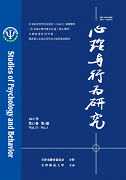|
|
The Effect of Specific Emotion and Personality Trait on Information Process of Decision-Making
Wang Dawei, Qiao Xiuqing, Su Xiang, Xu Ping, Liu Hongli, Hu Yixin
2017, 15(3):
295-301.
We explored the impacts of emotion and personality trait on on the process of decision making. The results showed that: 1)In the mean decision time, specific emotions and personality traits had significant main effect and interaction effect on information process of decision making. In the sad emotion, individuals with internal control personality spent longer average decision time than ones with external control personality. The individuals with internal control personality spent longer average decision time in the sad emotion than in happy emotion. 2)As for the depth of decision information search, specific emotions and personality traits had a significant main effect and an interaction effect on information process of decision making. Under the sad emotion, individuals with internal control personality searched more information than ones with external control personality. The individuals with internal control personality searched more information in the sad emotion than in happy emotion. 3)In terms of the pattern of decision information search, the main effects of specific emotions and personality traits were significant, but the interaction was not. The individuals with internal control personality were inclined to process information based on alternative in sad emotion, and the individuals with internal control personality preferred to process more information based on options in sad emotion than in happy emotion. The individuals with external control personality preferred to process more information based on attribute in sad emotion than in happy emotion.
|

